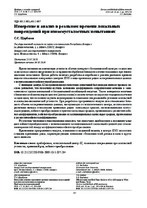| dc.contributor.author | Щербаков, С. С. | |
| dc.coverage.spatial | Минск | ru |
| dc.date.accessioned | 2019-06-27T08:42:32Z | |
| dc.date.available | 2019-06-27T08:42:32Z | |
| dc.date.issued | 2019 | |
| dc.identifier.citation | Щербаков, С. С. Измерение и анализ в реальном времени локальных повреждений при износоусталостных испытаниях = Measurement and Real Time Analysis of Local Damage in Wear-and-Fatigue Tests / С. С. Щербаков // Приборы и методы измерений : научно-технический журнал. – 2019. – Т. 10, № 2. – С. 207-214. | ru |
| dc.identifier.uri | https://rep.bntu.by/handle/data/53913 | |
| dc.description.abstract | При испытаниях на контактную усталость обычно измеряют сближение осей один раз за цикл или за несколько циклов нагружения из-за трудности обработки большого количества данных при многоцикловых испытаниях. Целью работы являлась разработка и апробация в режиме реального времени модели сглаживания измеряемых центром SZ-01 в виде временных рядов экспериментальных данных с использованием вейвлет-преобразования. С помощью центра SZ во время износоусталостных испытаний был измерен момент трения в системе ролик/вал, что позволило изучить изменение коэффициента сопротивления качению в зависимости от уровня контактной и бесконтактной изгибающей нагрузки. Также измерялась величина сближения осей контактирующих тел (ролика и вала) в восьми точках на окружности дорожки качения за один цикл, что позволило изучить неоднородность локальных повреждений в условиях контактной и контактно-механической усталости. При разработке программного модуля для сглаживания большого объема экспериментальных данных, поступающих от испытательного центра, использовались различные методы сглаживания временных рядов: скользящая средняя; экспоненциальная скользящая средняя; вейвлетреобразование и простая скользящая средняя, примененная к разностям вейвлет-коэффициентов; вейвлет-преобразование и экспоненциальная скользящая средняя, примененная к разностям вейвлет-коэффициентов.
Результаты численного моделирования показали, что наилучшее приближение к исходному ряду дает вейвлетреобразование с использованием экспоненциальной скользящей средней для сглаживания разностей между коэффициентами вейвлет-преобразования. Применение программного модуля, основанного на данной модели, в центре SZ-01 позволило сгладить временные ряды, характеризующие изменение сближения осей ролика и вала и крутящего момента. | ru |
| dc.language.iso | ru | ru |
| dc.publisher | БНТУ | ru |
| dc.title | Измерение и анализ в реальном времени локальных повреждений при износоусталостных испытаниях | ru |
| dc.title.alternative | Measurement and Real Time Analysis of Local Damage in Wear-and-Fatigue Tests | ru |
| dc.type | Article | ru |
| dc.identifier.doi | 10.21122/2220-9506-2019-10-2-207-214 | |
| local.description.annotation | In rolling fatigue tests the approach of the axes is usually measured once per cycle or for several loading cycles because of the difficulties of processing a large amount of data in multi-cycle testing. The aim of this work was the development and tests of smoothing model for measured by the SZ-01 center time series experimental data using wavelet transform.
With the help of the SZ center, the frictional moment in the roller/shaft system was measured allowing for studying the change in the coefficient of rolling resistance as a function of the level of the contact and non-contact bending load during wear-fatigue tests. Also the axes approach of the contacting bodies (roller and shaft) was measured at eight points on the raceway circumference in one cycle. This allowed studying the heterogeneity of local damages under conditions of rolling and mechano-rolling fatigue. When developing a software module for smoothing a large amount of experimental data from the test center, various methods of time series smoothing were used: moving average; exponential moving average; wavelet transform and moving average applied to the differences of the wavelet coefficients; wavelet transform and exponential moving average applied to the difference of the wavelet coefficients. The results of numerical simulation showed that the best approximation to the original series was provided by the wavelet transform using an exponential moving average to smooth the differences between the coefficients of the wavelet transform. The use of a software module based on this model in SZ-01 center allowed smoothing the time series characterizing the change of roller and shaft axes approach and torque. | ru |

